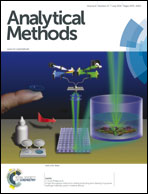Electrochemical detection of sulphide in water/seawater using nanostructured carbon–epoxy composite electrodes
Abstract
In this study, the performance of a carbon nanofibre–epoxy composite (CNF) electrode was compared with that of a boron-doped diamond (BDD) electrode for the voltammetric/amperometric direct detection of sulphide in water and seawater by cyclic voltammetry (CV), differential pulse voltammetry (DPV) and square-wave voltammetry (SWV). Both electrodes allowed direct detection of sulphides in aqueous solutions, and carbon nanofibres exhibited a catalytic effect towards sulphide oxidation, which led to the best sensitivity. The best electroanalytical parameters were achieved using pulsed voltammetric techniques, with optimized square-wave voltammetry achieving the best sensitivity of 347.899 μA mM−1 for sulphide detection. However, the chronoamperometry (CA) results achieved with real water without any supporting electrolyte were also very promising for the practical use of CNF electrodes for the in-field direct detection of sulphide in water and seawater.


 Please wait while we load your content...
Please wait while we load your content...